
What is Breast Cancer?
Breast cancer is a cancer originating from milk ducts, connective tissues around milk ducts or mammary glands.
Cancer is actually uncontrolled proliferation of cells. If the treatment process for uncontrolled proliferating cells is not initiated, rapidly proliferating cells spread throughout the body. In this case, additional problems begin to occur based on the organ in which the cells spread.
Breast cancer can spread to armpit, bones, liver, lungs, brain and other organs.
Early diagnosis is the most important factor that increases the success rate of treatment.
Symptoms of Breast Cancer
Many of the symptoms that we will list as symptoms of breast cancer can also be incident in benign breast diseases. Therefore, such symptoms should not scare you, but should ensure you to be examined by a general surgeon without wasting time.
- Palpable lump on breasts or armpit
- Clear or bloody nipple discharge which occurs on their own
- Lump, oedema and dimpling (orange peel skin) in breasts
- Prominence in breast vessels
- Growth and deformation of the breasts
- Crusting, peeling, wound formation on breast skin
- Rash on breasts
- Dimpling on breasts
Factors that increase the Risk of Breast Cancer
- Female gender: breast cancer is incident in women 100 times more than in men
- Age: The older one gets, the more the risk of breast cancer increases
Breast cancer history in the family (sister, mother, grandmother, aunt, daughter) is one of the conditions increasing the risk and if these relatives have bilateral breast cancer, the risk of breast cancer at a young age further increases - Menstruation at an early age and menopause at an old age increases the risk
- Some medications used to reduce post-menopausal complaints increase the risk of breast cancer when used for a long time (more than 5 years)
- Gaining weight, a fatty diet are of the factors that increase the risk
- Radiation therapies received for other diseases in the past, increase the risk
- BRCA-1 and BRCA-2 gene mutations increase the risk of breast cancer
Factors that reduce the Risk of Breast Cancer
- Regular exercise and physical activity
- Breastfeeding
- Limiting fatty foods
- Limiting alcohol consumption
- Maintaining the ideal weight
How is Breast Cancer Diagnosed?
When you go for a breast examination, your doctor will examine you for about 10 minutes. Your nipples, breast tissue, and armpits are evaluated for possible breast disease during the examination. Your doctor might request for tests such as breast ultrasonography, mammography, breast MRI in terms of findings detected during breast examination or problems that might not be detected during examination. Your doctor might recommend biopsy, surgery or follow-up based on your test results. The follow-up process can be at different intervals for each patient.
If a suspicious mass is detected in the breast, a surgical fine-needle or tru-cut biopsy, where the whole of part of the mass in the breast is removed, might be planned. A final diagnosis as to whether the masses detected in the breast are benign or malignant can be established by pathological examination.
Get Online Appointment/Information
Is breast pain a symptom of cancer?
There are mammary glands in the breast and milk ducts in between the mammary glands and the nipples. There is fluid in the milk ducts apart from breastfeeding period, as well. Hormonal changes occuring during menstrual cycle affect the amount of fluid in the milk ducts, resulting in an increase in pressure and sometimes causing pain. In general, this situation is the cause of breast aches, however sometimes breast infections and masses growing in the breast might cause similar aches. Therefore, we can say that breast ache is not a general sign of breast cancer. However, a sweeping statement as ‘patients with breast ache are not cancer’ cannot be made.
What Percentage is the Chance of Recovery from Breast Cancer?
5-year survival rates of patients with early diagnosis are above 95%.
Does Menopause Increase the Risk of Breast Cancer?
As age increases, the risk of breast cancer increases too. Menopause at an old age also increases the risk. However, entering menopause is not a condition that increases the risk.
Is the Whole Breast Removed in Breast Cancer?
Different surgical techniques might be applied depending on the clinical picture of the patient and the stage of the disease in the treatment of breast cancer. In general, breast-conserving surgeries, i.e., surgeries, only a part of breast is removed and the structure of breast is conserved, are possible. As long as our patients are not late for diagnosis.
Is there a prosthetic breast instead to replace the breast when it is removed?
In patients, whose entire breast needs to be removed, it is possible to make new breast out of her own muscles or apply a silicone breast prosthesis.
What Is Sentinel Lymph Node Biopsy for Breast Cancer?
Sentinel lymph node biopsy is the process of finding and examining lymph nodes in order to find out whether or not cancer cells that are close to the area and that are likely to spread, have spreaded or not.
What Advantage does Sentinel Lymph Node Biopsy Provide?
In diseases, where the breast cancer is only limited to breasts, the necessity to remove lymph nodes under the armpit is eliminated. Removal of all lymph nodes under the armpit requires that arm to be conserved lifelong and the risk of lymphoedema increases.
Sentinel lymph node biopsy is successfully applied by me and my team during the surgery planned for the patients we need necessary and we protect our patients from unnecessary surgical burdens and risks.
What kind of a path is followed if a pregnant or a breastfeeding woman has breast cancer?
Breast cancer treatment in pregnant women is generally the same as the women that are not pregnant. Surgery can be performed and chemotherapy can be prescribed after the 3 months of pregnancy, evaluating certain risks. Commencement of radiotherapy after birth will be more appropriate for patients that need radiotherapy.
What is Mammography? Is there an age limit for mammography?
Mammography is a method that evaluates breast tissue using X-ray. It can be used for patients over 40 years of age for screening. It can be used for those aged 35-40 years if the clinical picture requires so. Mammography is a method that can diagnose breast cancer at a very early stage.
What is breast MRI?
MRI is a method that has advantages in evaluating soft tissues. It is superior to other methods in evaluating breast tissue after breast surgeries that have been undergone or breast prosthesis. It might result in highly useful findings in its use in breast, when a good radiology team and a device are present. It can be used for breast screening in patients with high risk.
What is Breast Ultrasound?
It is the process, where the breast tissue is evaluated using devices that capture images using sound waves. It has no side effects or harm. It can also be applied to pregnant women safely. It is the standard method used in patients under the age of 35 for breast evaluation. It is a method, disadvantage of which depends on the person. It is a guide in evaluation the internal structure, blood flow and margins.
Breast Cancer Treatment
There are many alternatives among treatment protocols of breast cancer. Since it is clear that these alternatives are not often superior to each other, the doctor, who will perform the surgery can offer you many alternatives. All these alternatives are selected from the right methods that can be administered.
We determine the treatment process of our patients with breast cancer by considering all treatment modalities. In patients that we decide on the removal of the breast, we can make a new breast using the tissues of the body or silicone prosthesis at the same time, if patients wish so.
After breast cancer surgeries, some of our patients undergo chemotherapy and some of them undergo radiotherapy process, additionally. We aim to combine these processes and to save our patients from this disease and enable them to continue their lives with their loved ones.
“You can contact us and get detailed information in regard to all kinds of questions and problems.”
 TR
TR EN
EN AR
AR

